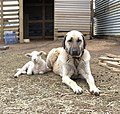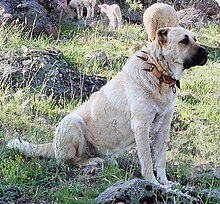Kangal Shepherd Dog
| Kangal | |||||||||||||||||||||||||
|---|---|---|---|---|---|---|---|---|---|---|---|---|---|---|---|---|---|---|---|---|---|---|---|---|---|
 | |||||||||||||||||||||||||
| Origin | Turkey | ||||||||||||||||||||||||
| |||||||||||||||||||||||||
| |||||||||||||||||||||||||
| Dog (domestic dog) | |||||||||||||||||||||||||
The Kangal Shepherd Dog is a breed of large livestock guardian dog in Sivas, Turkey. Originally the breed served people of Sivas, where the Kangal continues to be a popular dog breed in Turkey. According to official Kangal Shepherd Dog organisations in Turkey, including the Cynology Federation of Turkey (Köpek Irkları ve Kinoloji Federasyonu, KIF) and the Ankara Kangal Association (Ankara Kangal Derneği, ANKADER) the acceptable colours for Kangal are sable and fawn. Kangal shepherd dogs do not come in brindle or Black and Tan.
While the Kangal Shepherd Dog is often referred to as a sheep dog, it is not a herding dog, but rather a flock guardian that lives with the flock of sheep to actively fend off predators of all sizes. Typically used as protection against wolves, bears, and jackals in its native Turkey,[1][2] the breed has been exported to African countries like Namibia and Kenya in more recent years[3][4] due to its intimidating size and capabilities as an effective guardian, where it successfully protects local herds from lions, cheetahs, and similar indigenous big cats, which has had the benefit of not only protecting livestock, but ensuring the continuity of endangered predators due to reduced cullings by local farmers.[5]
Origins[]
The breed's name derives from the contemporary Central Anatolian town of Kangal in Turkey's Sivas Province.
A DNA study found that the dogs of Kazakhstan, Uzbekistan, Tadjikistan and Afghanistan are genetically closest to Kangal dogs, and the researchers propose that the breed may have been brought from Central Asia by the nomadic Turks.[6]
Anatolian Shepherd[]

Anatolian Shepherd Dog is the name used in the United States to describe dogs descended from regional Turkish livestock guardian dogs, particularly the Kangal but also the Akbash, from the late 1960s.[7] In 1967 a US Navy Lieutenant who was stationed in Turkey, Robert Ballard, acquired two working livestock guardians Zorba and Peki, from breeders in the Ankara region, Zorba was a long-coated pinto-colored dog and Peki a short-coated buff-colored bitch.[7][8] In the late 1960s Ballard returned to the United States and took his dogs with him and in 1970 the pair bred their first litter, becoming the foundation stock of the breed in the United States, a breed club was quickly formed and further examples were imported from Turkey.[7] In developing the breed, the American enthusiasts acted without understanding of regional Turkish varieties of shepherd's dogs, with the result that the American dogs could be bred with various coat lengths, colors and color patterns whilst in Turkey the different breeds breed more true to a set coat type.[7] This was further exacerbated by most of these dogs being sourced in the intermediate zone between the main breeding centers of the Akbash and the Kangal, where examples of both types can be found.[7]
In subsequent years animosity developed between American breeders, who insisted their dogs were the true Turkish shepherd's dog, and Turkish breeders who believed, and stated, they were an amalgam of various Turkish breed.[7] Insults and counter-insults were exchanged with American breeders accusing the Turks of marketing dogs of dubious ancestry as independent breeds and the Turks stating the Americans were breeding crossbred dogs.[7] The name Anatolian Shepherd Dog is unknown in Turkey and the breed is sometimes described as having the Turkish name of Çoban Köpeği which means 'shepherd's dog', or livestock guardian dog.[7][9] Since the 1980s Americans have almost exclusively imported Kangals and the Anatolian has increasingly conformed to that breed type, despite this pups of mixed appearance are still whelped and Turkish authorities still refuse to recognise Anatolians as a purebred Turkish breed.[7]
Appearance[]
Turkey is the country of authority for Kangal standard. In the Kangal Shepherd Dog's homeland of Turkey, the only measurements desired are quoted by KIF as a height at the withers of 65 to 78 cm (25+1⁄2 to 30+1⁄2 in), with a 2-centimetre (1 in) tolerance either way. KIF is the reigning canine council affiliated with international Fédération Cynologique Internationale, and the true owners of the Kangal Shepherd Dog breed.
The Kangal Shepherd Dog is not as heavy as some other Mastiff breeds, allowing it greater speed and agility than larger dogs. Kangal Shepherd Dogs can reach speeds of up to 56 km/h (35 mph).[10] The under-layer provides insulation against both severe Anatolian winters and the fierce summer sun, while the outer-layer repels water and snow. This combination of coat allows it to regulate its core temperature more efficiently, while the coat is dense enough to repel rupture from wolf bites.[10]
Cropping of the ears is done for several reasons including the cultural demonstration of ownership versus feral dogs, for appearance, and for protection – as long ears can be vulnerable in a physical confrontation with a predator.[citation needed] The cropping of ears is illegal in the UK.

A Kangal with cropped ears

Kangal puppy eating yogurt

The Kangal dog can be a good house dog if effectively trained from birth.



Protector of flocks
Temperament[]
The Kangal Shepherd Dog is calm, controlled, independent, powerful and protective. They may be aloof towards strangers, but a well-socialized Kangal Dog is friendly with visitors and especially children. They must never be shy or vicious. A well-trained Kangal Shepherd Dog is sensitive and alert to changing situations, responding to threats with judicious warnings and courageous action if necessary. They make good guardians of livestock and humans alike, but they may not be suitable for inexperienced dog owners, as the independent intelligence of the Kangal makes for a difficult pupil.
Protective behavior[]

A working Kangal Shepherd Dog on duty will station itself on a high vantage point overlooking its flock. On hot days, the dog will dig itself a hollow in the ground to keep cool. Novices learn by staying close to older dogs. The dogs will work in pairs or teams depending on the size of the flock, taking up positions around the sheep and changing their positions as needed. The intensity of their patrols around the sheep increases at nightfall.
When suspicious, a Kangal Shepherd Dog will stand with its tail and ears erect and give an alarm call, inciting the sheep to gather around it for protection. The Kangal Shepherd Dog's first instinct is to place itself between the perceived threat and the sheep or master. Once the sheep are safely behind it, the Kangal Shepherd Dog confronts the intruder. When faced with a wolf, the Kangal Shepherd Dog sometimes is successful in intimidating the enemy, but it will resort to a physical confrontation if the predator stands its ground.[10]
The Kangal Shepherd Dog internationally[]
In October 2012, The Kennel Club announced it will recognise the Kangal Shepherd Dog as a breed and classify it within the . This will allow the breed to be exhibited at KC licensed events in the UK from July 2013.[11] In December 2012 an interim Breed standard for the breed will be issued.[12] The interim standard was issued in January 2013.[13]
On 25 June 2018, the FCI published the official Kangal Shepherd Dog breed standard to replace the previous Anatolian Shepherd Dog standard due to the breed not being recognised in Turkey.
Around 300 Kangal Shepherd Dogs have been given to farmers in Namibia since 1994 by the Cheetah Conservation Fund (CCF) to help protect livestock from cheetah attacks, and the program has been extended to Kenya.[14] Since then, the number of cheetahs killed by farmers is calculated to have fallen from 19 per farmer annually to 2.4. Livestock losses have been cut significantly at more than 80% of the farms where the dogs have been adopted. The great majority of cheetahs that are still killed by farmers are killed after specific attacks on livestock. Previously, the cats were tracked and killed whenever they neared a farm.
See also[]
- Dogs portal
- List of dog breeds
- Akbash dog
- Aksaray Malaklisi dog
- Kars
References[]
- ^ [1]
- ^ "US researchers hope more assertive, foreign dog breeds can protect livestock from wolves and bears". Pri.org. Retrieved 11 December 2017.
- ^ "Guard dogs save Namibian cheetahs". BBC News. 31 December 2008. Retrieved 11 December 2017.
- ^ Waldo (16 November 2013). "Namibia: Cheetah Fund Sends Kangal Dogs to Tanzania". Allafrica.com. Retrieved 11 December 2017.
- ^ "Kangal Dogs Save Cheetahs From Extinction In Africa". web.archive.org. 20 April 2015.
- ^ Koban, Evren; Saraç, Çiğdem Gökçek; Açan, Sinan Can; Sovalainen, Peter; Togan, Inci (2009). "Genetic relationship between Kangal, Akbash and other dog populations". Discrete Applied Mathematics. doi:10.1016/j.dam.2008.06.040. hdl:11511/28384.
- ^ Jump up to: a b c d e f g h i Morris, Desmond (2001). Dogs: the ultimate dictionary of over 1,000 dog breeds. North Pomfret, VT: Trafalgar Square Publishing. pp. 393–396. ISBN 1-57076-219-8.
- ^ Wilcox, Bonnie; Walkowicz, Chris (1995). Atlas of dog breeds of the world. Neptune City, N.J.: TFH Publications. pp. 123–124.
- ^ Yilmaz, Orhan (2007). Turkish kangal (Karabash) shepherd dog (PDF). Ankara: Impress Printing Comp. pp. 11–12.
- ^ Jump up to: a b c "The Kangal Dog of Turkey". Retrieved 29 December 2010.
- ^ "KC to recognise the Turkish Kangal Dog". Dog World. Archived from the original on 31 December 2013. Retrieved 4 October 2012.
- ^ "Recognition of the Turkish Kangal dog". Kennel Club. Archived from the original on 11 October 2012. Retrieved 4 October 2012.
- ^ "Turkish Kangal Dog; proposed interim standard". The Kennel Club. Archived from the original on 23 April 2013. Retrieved 19 January 2013.
- ^ Smith, Lewis (26 December 2008). "How mans best friend is saving endangered big cat". The Times. London. Retrieved 16 June 2021.
External links[]
| Wikimedia Commons has media related to Kangal Dog. |
- Dog breeds originating in Turkey
- FCI breeds
- Livestock guardian dogs





